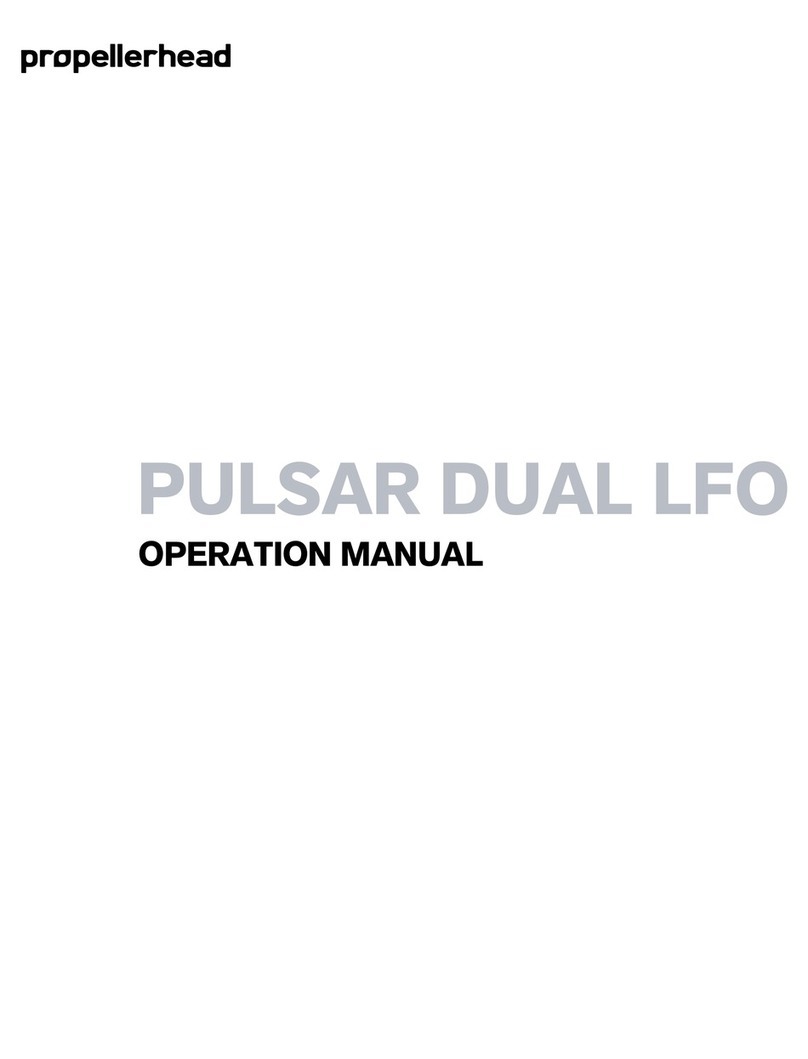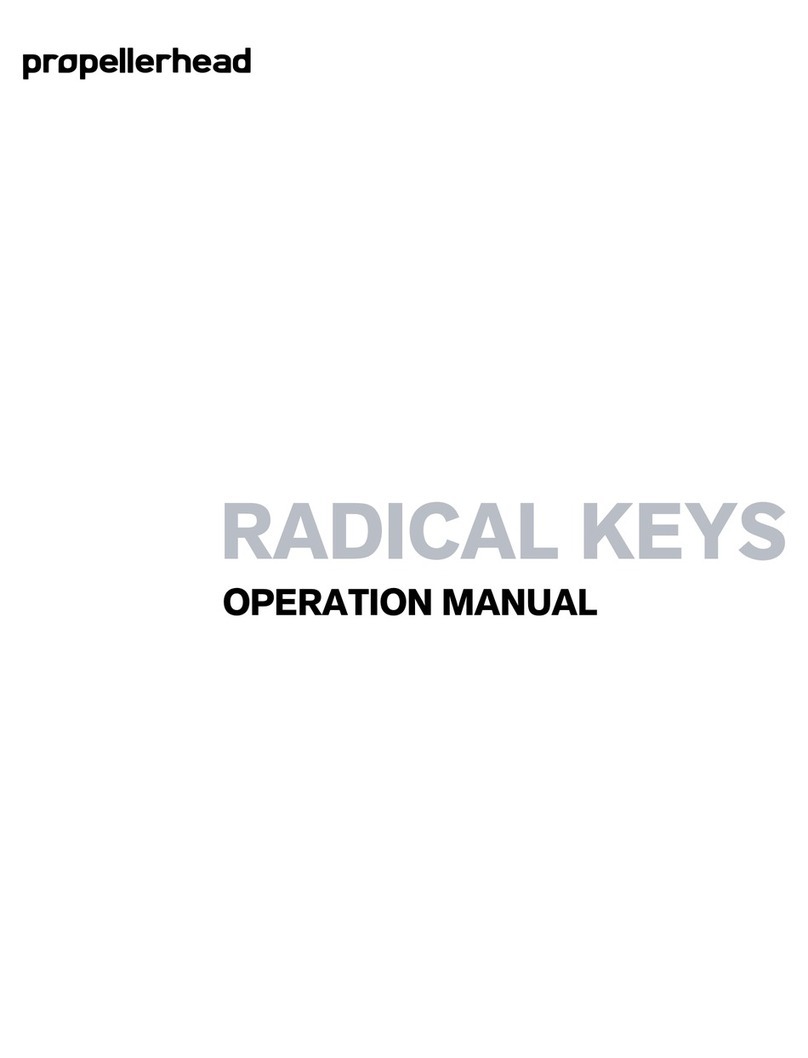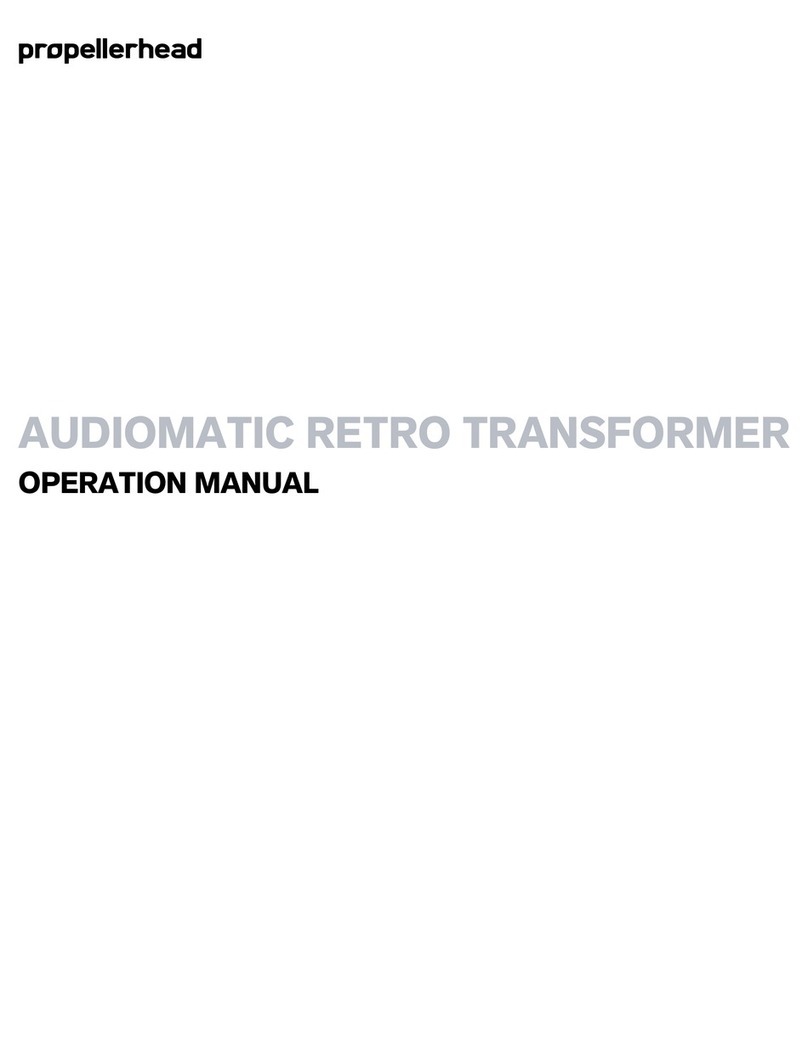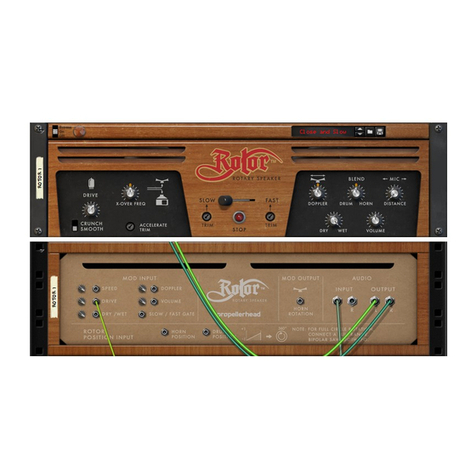Propellerhead RADICAL PIANO User manual

RADICAL PIANO
OPERATION MANUAL

The information in this document is subject to change without notice and does not represent a commitment on the
part of Propellerhead Software AB. The software described herein is subject to a License Agreement and may not be
copied to any other media expect as specifically allowed in the License Agreement. No part of this publication may be
copied, reproduced or otherwise transmitted or recorded, for any purpose, without prior written permission by
Propellerhead Software AB.
©2012 Propellerhead Software and its licensors. All specifications subject to change without notice. Reason,
Reason Essentials and Rack Extension are trademarks of Propellerhead Software. All other commercial symbols
are protected trademarks and trade names of their respective holders. All rights reserved.

Radical Piano

RADICAL PIANO
4
Introduction
Radical Piano is a Propellerhead Rack Extension device designed to be a straightforward, awesome sounding and
very flexible piano. Radical Piano combines sample playback technology with physical modelling to give you great
sound quality and seamless dynamic response as well as great freedom to tweak your sounds.
The combination of sample playback and physical modelling also makes it possible to keep each piano sound set
down to a minimum size. This allows for very quick loading times when you switch between instruments.
Radical Piano also features sympathetic resonance, which means that any undamped strings will ring along with the
played notes (strings), just like on acoustic pianos. This makes Radical Piano sound extremely realistic and alive.
There are also a number of other controls for further shaping the sound the way you want it.
As a bonus, we also included an audio input so you can route external audio and process it in Radical Piano!
The pianos
Radical Piano holds complete sound sets recorded from these three pianos:
•HomeGrand
A Bechstein grand piano with a nice “not perfectly tuned” home grand character.
• Deluxe Grand
A Steinway Model D grand piano - one of the greatest grand pianos out there. This particular one belongs to
Sveriges Radio (Swedish Radio Ltd).
• Upright
A Futura upright piano with a distinct “living room” character.

RADICAL PIANO 5
The microphone configurations
The microphone configurations for the grand pianos and the upright piano respectively.
The pianos were recorded using up to nine microphones per instrument, placed at various critical positions inside and
outside of the pianos. The different microphone recordings were then stored in Radical Piano as separate sound sets.
The following microphone configurations were used:
•VintageMono
A single microphone placed outside the waist of the grand piano (or behind the upright piano). For the Steinway
grand piano we used an old school mono ribbon mic with vintage characteristics and a narrow frequency response
with the emphasis in the mid range. For the Futura upright piano we used a vintage tube microphone.
•Ambience
Two microphones in AB configuration* placed quite far away from the piano to capture the room ambience.
•Floor
Two pressure zone microphones that lay flat on the floor just behind the front legs of the grand piano (and behind
the upright piano). They add depth and richness to the sound and are best used as a complement to the other
mics.
•Jazz
Two microphones in AB configuration* placed just outside/in front of the piano. This gives a full bodied sound with
a wide stereo image and a less pronounced attack.
•Close
Two microphones in XY configuration** placed close to the hammers. The close mics produce a distinct sound with
a sharp attack, ideal for uptempo pop/rock.
* AB configuration: Two mics in stereo configuration placed several feet apart and tilted slightly away from each
other.
** XY configuration: Two mics in stereo configuration placed close together in 'V' shape at a 90° coincidence.

RADICAL PIANO
6
Using Radical Piano
Loading and saving patches
Loading and saving patches is done in the same way as with any other internal Reason/Reason Essentials device -
see the “Sounds and Patches” chapter in the Reason/Reason Essentials Operation Manual pdf for details.
Selecting piano sound sets
A patch in Radical Piano can consist of a mix between two piano sound sets. The mix could be between two sound
sets from the same piano, or from different pianos. You could, for example, blend a Close mic’ed upright piano with
the Floor microphones from a grand piano to create your own custom piano sound. The piano sound sets can be
selected in the Piano Select section:
The Piano Select section.
1. Select desired piano sound set(s) by clicking the corresponding LED button(s).
You can select one sound set to the left of the Blend knob and one to the right.
2. Set the mix between the sound sets with the Blend Microphones knob.
If you only want to use a single sound set for your sound, set the Microphone Blend knob to min or max.
Character
DSet the character of the sound with the Character knob.
Range: Subdued to Agitated, in 24 steps, with natural sound at the 12 o’clock position.
Subdued produces a warm and mellow tone whereas Agitated generates a brighter and significantly more
pronounced tone.
!Changing the Character value temporarily mutes the audio outputs.

RADICAL PIANO 7
Volume
The master volume control for Radical Piano.
Velocity Response
Most sample-based piano instruments and sound libraries on the market use a predefined number of velocity layers.
Depending on how soft or hard you play the keys, samples from a specific velocity layer play back. Due to memory
limitations, the number of velocity layers aren’t often that many. This can make the velocity response feel and sound
unnatural. Thanks to the combination of samples and physical modelling in Radical Piano, all sound sets feature very
wide and completely seamless velocity ranges.
With the Velocity Response knobs you can tailor the dynamic response of your piano sound.
• With the High knob you set the timbre for the highest velocity.
Note that the High parameter can go far beyond the natural range of an acoustic piano, which is great for
experimental sounds.
• With the Low knob you set the timbre for the lowest velocity.
With the Low knob set to zero (marked with an ‘S’) playing really soft won’t play back any sound at all. This can be
useful if you, for example, want to hold down a chord and then play other keys to introduce the sympathetic
resonance effect, see “Resonance”.
• With the Curve knob you set the shape of the velocity curve - from exponential, via linear to logarithmic.
Set this parameter where it feels the best to play. There is no “perfect” position since most MIDI keyboards
respond differently to velocity.
qIf you want a natural dynamic range, set the Low knob to around the 9 o’clock position and the High knob to
around the 12 o’clock position. Adjust the Curve setting to your liking.
qIf you want a dynamic range that stretches beyond the range of an acoustic piano, set the Low knob to zero
and the High knob past the 12 o’clock position.
qIf you want a static response (with the same timbre no matter how soft or hard you play), set the Low knob to
max and the High knob to zero. Note that there will still be some velocity sensitivity left for controlling the
volume.

RADICAL PIANO
8
Tune
Cent
DSet the overall master tune of your sound with the Cent knob.
Range: +/-1 semitone (+/-100 cents).
Drift
The Drift parameter can be used for introducing a slow irregular pitch variation to your sound. It’s perfect for adding
kind of a “scary” or melancholic touch to your piano sound.
Sustain
The Sustain parameter is a special feature in Radical Piano. It lets you control the piano sustain continuously from
pedal up to pedal down. As on acoustic pianos, the sustain pedal is not either “on” or “off - it can be “somewhere in
between” as well. The Sustain function in Radical Piano simulates this behavior.
The Sustain parameter can be controlled either from the Pedal LED strip control on the front panel or from a Sustain
pedal connected to the Sustain Pedal input of your MIDI master keyboard.
• When you use a standard (switch type) sustain pedal connected to a standard sustain pedal input on your MIDI
keyboard, this will control the Sustain function in Radical Piano as either Off (‘0’) or On (‘127’).
You could record using the standard sustain pedal and then manually edit the Sustain Pedal performance
controller data in the note clip in Reason/Reason Essentials afterwards and adjust the “in between” Sustain levels.
!The Sustain parameter value (and LED bar) will always adjust to the latest incoming Sustain Pedal data, be it
from the Pedal LED strip control or from a sustain pedal connected to your MIDI keyboard.

RADICAL PIANO 9
Resonance
Sympathetic resonance is a physical phenomenon that can occur in acoustic instruments, like in pianos for example.
It means that any undamped strings will ring along with the played strings. For example, if you play a key with the
sustain pedal down, all other strings in the piano will also vibrate at various intensities. Similarly, if you hold down a
number of keys (so that the dampers are off the strings) and then play additional keys, the strings for the held keys
will resonate.
With the Resonance controls you set the amount of sympathetic resonance in your piano sound.
Level
DSet the amount of overall sympathetic resonance in your sound.
Release Time
DSet the time it should take for the sympathetic resonance to fade to silence.
Envelope
Radical Piano features a special type of envelope generator which is used for shaping the character of the piano
sound.
Attack
DSet the attack time for the piano sound, from immediate to (unnaturally) slow.
The range is 0-200 ms.
Decay Curve
DSet the shape of the decay curve.
This control determines how the sound should decay when you play and hold the keys.
The range is from exponential, via linear, to logarithmic. Exponential settings will make the sound decay faster,
which simulates a piano with little body sustain. Logarithmic settings makes the sound sustain more slowly and
simulates a piano with a lot of body sustain.

RADICAL PIANO
10
Release
DSet the time it should take for the sound to fade to silence once you release the keys.
This simulates the behavior of the dampers. For example, worn out dampers could result in somewhat longer
release times.
Mechanics
The Mechanics section features controls for the mechanical noise.
Key Down
• Key Down controls the level - and character - of the noise that occurs when the keys are pressed/hit.
At the 12 o’clock position the noise is the most natural. Above the 12 o’clock position the noise is more
pronounced and below the 12 o’clock position the noise is suppressed.
Key Up
• Key Up controls the level of the noise that occurs when the keys are released and the hammers and dampers
return to their initial positions.
At the 12 o’clock position the noise level is natural. Above the 12 o’clock position the noise is louder and below the
12 o’clock position the noise is quieter.
Pedal
• Pedal controls the level of the noise that occurs when you press and release the sustain pedal.
At the 12 o’clock position the noise level is natural. Above the 12 o’clock position the noise is louder and below the
12 o’clock position the noise is quieter.
EQ
The built-in equalizer is a powerful 3-band EQ with gain controls for the Low, Mid and High bands. The EQ
characteristics have been fine tuned and optimized for piano sounds. The gain range is +/-18dB for each of the
bands, which makes it easy to quickly achieve great sonic results.
The EQ can be switched on/off by clicking the LED button at the top.

RADICAL PIANO 11
Ambience
The Ambience section features four different reverb types and a Level control. The reverb types are:
• Small Room
This simulates the acoustic reflections in a small room.
•LargeRoom
This simulates the acoustic reflections in a large room.
•Hall
This simulates the acoustic reflections in a medium size hall.
• Theater
This simulates the acoustic reflections in a large hall/theater.
Output
Width
This lets you set the stereo width of the piano sound.
!Note that the Width control does not have any effect on the sound if you use only the “Vintage Mono” piano
sound set(s), see “Selecting piano sound sets”.
Compression
This controls the amount of compression of your piano sound.

RADICAL PIANO
12
Connections
!Remember that CV connections will not be stored in the Radical Piano patch!
Sequencer Control
The Sequencer Control CV and Gate inputs allow you to play Radical Piano from another CV/Gate device (typically a
Matrix or an RPG-8). The signal to the CV input controls the note pitch, while the signal to the Gate input delivers
note on/off along with velocity.
Modulation In
These control voltage (CV) inputs (with associated trim pots) can modulate following parameters in Radical Piano:
•Pitch
The Pitch can be modulated at a maximum range of +/-1 octave.
!Note that +/- 1 octave is the maximum range a piano sound can be pitch shifted in Radical Piano. This as-
sumes that no Pitch Bend performance controller is used (see “Pitch Bend”) and that the Character knob is set
to Natural (see “Character”).
•MasterVolume
Audio In
Route an external audio signal to this input to process it with the Resonance, EQ, Ambience and Compression effects
in Radical Piano.
qRouting a vocal signal and processing it with the sympathetic resonance effect (with the sustain pedal down)
could generate really interesting results. It would be like singing into a piano body!
Audio Out
These are the main audio outputs. When you create a new Radical Piano device, these outputs are auto-routed to the
first available channel in the main mixer in Reason.

RADICAL PIANO 13
Additional external control
The Radical Piano responds to the following standard Performance Controllers:
•PitchBend
Radical Piano responds to Pitch Bend data from the pitch bend control of your MIDI master keyboard.
The range is fixed at +/-7 semitones.
!Note that the Character setting (see “Character”) as well as any Pitch CV modulation (see “Pitch”) can reduce
the Pitch Bend range.
• Sustain Pedal
If you have a standard (switch type) sustain pedal connected to a standard Sustain Pedal input of your MIDI
master keyboard, this can be used for controlling Sustain On/Off. You can then edit the Sustain values in your
note clips in the sequencer afterwards and set continuous values all the way between 0-127, see “Sustain” for
more details.

RADICAL PIANO
14
Table of contents
Other Propellerhead Music Equipment manuals





















